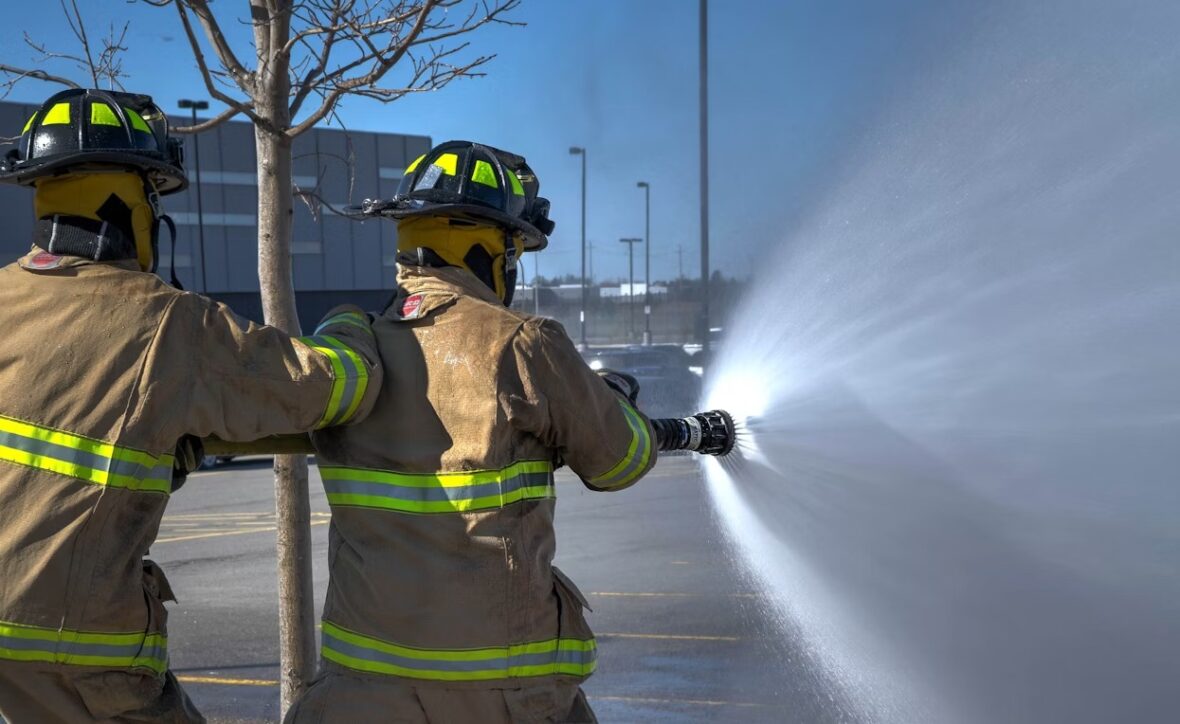For generations, firefighting foam has been a hero – effectively smothering dangerous fuel fires and keeping communities safe. However, a hidden cost has emerged. The very chemicals that extinguish these blazes, known as per- and polyfluoroalkyl substances (PFAS), are raising concerns about public health.
This article discusses the complex issue of firefighting foam contamination. We’ll explore its effectiveness in fire suppression, the dangers of PFAS, the potential health risks to communities, and the ongoing search for safer alternatives.
Effectiveness of Firefighting Foam
Aqueous film-forming foams (AFFF) stand as highly effective tools in fire suppression, particularly in scenarios involving flammable liquids such as jet fuel. Their efficacy lies in their ability to smother fires by creating a film atop the fuel surface. This effectively cuts off the fire’s oxygen supply and hinders the release of flammable vapors, preventing the fire from reigniting and spreading.
AFFF has proven indispensable in safeguarding lives and property. It is particularly relevant in high-risk environments like airports, industrial facilities, and refineries where flammable liquid hazards are prevalent.
Its rapid and efficient deployment in emergencies has contributed significantly to fire safety measures, helping to mitigate potential disasters.
The Contamination Problem
AFFF poses a significant contamination problem due to its inclusion of PFAS, often referred to as “forever chemicals” due to their environmental persistence. When AFFF is used in firefighting activities, PFAS compounds can infiltrate the soil and contaminate groundwater reservoirs, leading to widespread environmental pollution.
Moreover, training exercises and incidents such as spills during transportation or storage contribute to this contamination issue.
According to Spectrum News, a poignant example is the 2021 incident at the U.S. Navy’s Red Hill Fuel Storage Facility in Oahu. During the incident, fuel leaked into the groundwater, affecting thousands reliant on the Navy’s water system. Subsequently, another spill of AFFF containing PFAS occurred at Red Hill, exacerbating concerns about environmental and public health impacts.
Despite mounting pressure, the closure of the Red Hill facility is a slow process, with the facility not expected to shut down until 2027. The Navy’s plan to repurpose Red Hill raises concerns about the complex challenges associated with mitigating AFFF contamination.
Public Health Risks Associated with Firefighting Foam Exposure
Exposure to PFAS found in firefighting foam has been associated with a range of concerning health risks. Research indicates that prolonged exposure to these compounds may elevate the risk of developing certain cancers, including testicular, kidney, and thyroid cancers.
These health concerns have prompted legal action. Individuals and communities affected by PFAS contamination seek accountability from manufacturers through the firefighting foam lawsuit.
Currently, a total of 7,170 AFFF lawsuits are pending consolidation. These lawsuits are being handled through Multidistrict Litigations (MDLs), which are legal procedures designed to handle multiple related civil lawsuits.
According to TorHoerman Law, MDLs consolidate cases into a single federal district court for pretrial proceedings. This consolidation streamlines legal proceedings and allows for more efficient handling of complex litigation involving firefighting foam contamination.
The Cost of Cleanup
Cleaning up PFAS contamination from groundwater poses significant challenges in terms of both cost and time. Current methods, such as filtering or treating the water, are expensive for municipalities and residents alike.
Additionally, the long-term health effects of PFAS exposure lead to additional healthcare costs for potentially affected individuals.
As per the Environmental Working Group (EWG), the Department of Defense (DOD) is grappling with a $4 billion rise in the expense of addressing polluted locations. Many of these sites are polluted by PFAS.
The estimated total for cleaning up DOD sites has risen to $31 billion, with a significant gap between this cost and the allocated budget. Moreover, some sites may not be cleaned up for over half a century due to funding constraints.
This underfunding exacerbates the challenge of addressing PFAS contamination effectively. It also highlights the urgent need for increased financial resources to address this environmental and public health crisis.
The Search for Alternatives
Efforts to find alternatives to traditional firefighting foams containing PFAS are underway, driven by ongoing research. These alternatives aim to maintain the high effectiveness of AFFF while eliminating the environmental and health risks associated with PFAS.
According to the Longview News-Journal, Texas is considering banning the use of AFFF in favor of fluorine-free firefighting foam. This synthetic fire suppressant forms a film over fire fuels, suffocating them and preventing reignition, without containing any PFAS.
Despite its potential environmental benefits, fluorine-free firefighting foam still poses challenges. It contains toxic chemicals such as surfactants, detergents, and solvents, which can pollute the environment and pose health risks to firefighters.
Solvent exposure may lead to central nervous system issues, respiratory irritation, and long-term health effects such as scleroderma and kidney cancer. Furthermore, solvent exposure has been linked to neurodegenerative diseases like Alzheimer’s and Parkinson’s.
As research into alternative firefighting foams continues, it’s crucial to balance effectiveness with environmental and health considerations for safer fire suppression methods.
Frequently Asked Questions
What are the environmental effects of foam fire extinguishers?
The fluorine compounds (PFAS) in AFFF foam extinguishers, while effective in firefighting, have been confirmed as toxic pollutants. They enter ecosystems, accumulating in water, food, and air, posing harm to the environment and living organisms.
Is firefighting foam biodegradable?
Firefighting foam, particularly those selected for wildland and structural fires, should ideally achieve 60% biodegradability within 28–42 days. This ensures environmental compatibility and minimizes ecological impact during and after firefighting operations.
What are the symptoms of AFFF exposure?
Symptoms of AFFF exposure may include persistent eye irritation, conjunctivitis, skin rashes, itching, and chemical burns. Prolonged exposure can lead to chronic dermatological issues and discomfort, depending on the duration and intensity of exposure to PFAS found in AFFF.
In conclusion, the story of firefighting foam contamination is a stark reminder of the unintended consequences that can arise from technological advancements. While AFFF has undoubtedly saved lives and property, its reliance on PFAS creates a significant public health and environmental burden.
Moving forward, a multi-pronged approach is necessary. Continued research and development of PFAS-free alternatives are crucial. Additionally, stricter regulations and transparent communication from manufacturers and government agencies are essential for safeguarding firefighters and communities.







